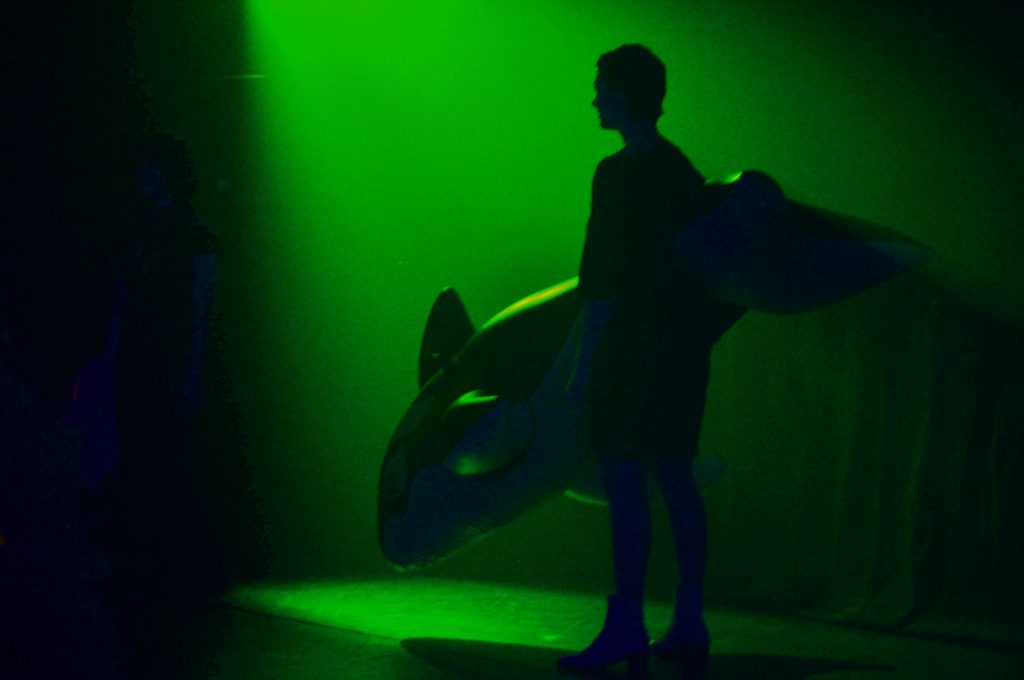Undertone
Undertone richt zich op het zintuiglijke vermogen van het publiek. Om uw toeschouwerschap op de proef te stellen en de conventionele kijkstrategieën uit de dagen, nodigt Undertone u uit in een pikzwarte ruimte waarin u kan deelnemen aan de orchestratie van fictionele ruimtes. In deze performance krijgen andere perceptiemechanismes de voorrang op visuele prikkels, via andere stimuli duikt u onder in een immersieve ervaring.
In Undertone wordt het lichaam van de toeschouwer gevraagd om naar zijn volle vermogen te voelen, te navigeren in een omgeving die bestaat uit een breed spectrum aan zintuiglijke ervaringen zoals smaken, geluiden, geuren, temperatuurschommelingen, aanrakingen en efemere scenografieën.
Officiële website: http://undertone2012.wordpress.com
Statements on the making of the piece Undertone
1. To remove spectatorship and destabilizing known ways of “watching” performances.
2. To engage the audience and the performers as active members of a collective event.
3. To propose in/audible stimulations, smells and interactive physical contacts in order to create performance as a situation of sensory stimulation and experience.
Few principles on how to treat and divide the sensorium:
– To cancel one/several sense(s) in order to enhance other(s).
– To emerge, submerse, dis-locate or amplify in the space sensory agents such as: sound, smell, light and other ephemeral scenographic materials.
– To mix, enhance or cancel declensions of one same sensory agent under sub-divisions such as: artificial/natural, subtle/overcharged, pleasant/unpleasant, analogue/digital, passive/active, static/transformative, personal/collective, …
4. To aim for subtleties that would be coupled with an overcharge, in order to make tiny little things going on in the theater space to gain an impact, which would be incongruous to their “size” or “weight”, as an intertwinement of perception. (Petra Sabisch)
5. To venture into situations where the notion of Individualism merges into the one of Community, and vice-versa.
6. To explore social situations which bring about sensible encounters between strangers. Something related to secrecy, social awkwardness and unspoken rules of behaviour. That is where one has to acknowledge her/his behaviour while taking part of the situation. (Bojana Cvejic)
7. To not be able to totally pre-determine what is going to happen in the space and how people will behave and interact with each other.
8. To stir the spectators into a zone that is never fully comfortable and certain without however being the opposite.
9. To produce simple but specific tasks for performance making in order to transmit this choreography to a large amount of performers within a short time frame (with the use of a score).
Credits
Concept and Choreography: Sidney Leoni
Since 2010, created together with and performed by: Amanda Apetrea, Andrea Csaszni Rygh, Andros Zins-Browne, Aron Blom, Atalante Eke, Alexandra Georgescu, Ben Evans, Benjamin Quigley, Christina Vantzou, Eliisa Erävalo, Emma Kim Hagdahl, Franziska Aigner, Guillem Mont de Palol, Halla Ólafsdóttir, Helga Guren, Ingrid Rusten, Ivar Furre Aam, Jorge Dutor, Koen Van de Wiele, Linnea Backgård, Linnea Martinsson, Louise Chardon, Ludvig Daae, Luís Miguel Félix, Luk Van den Dries, Manon Santkin, Marcus Doverud, Margareth Kaserer, Mariana My Suikkanen Gomes, Marianne De Boer, Mårten Spångberg, Martin Lervik, Maryam Nikandish, Mattias Lech, Monica Le Bruyn, Rami Jawhari Jansson, Sidney Leoni, Stina Nyberg, Sandy Williams, Tom Engels and Zoranne Serrano
Sound designer: Peter Lenaerts
Fragrance design: Laurent David Garnier
Technique: Roy Carroll, Joachim Hupfer, Nick Symons,
Funded by: Konstnärsnämnden, the Swedish Arts Grant Committee, Fond for lyd og bilde (Oslo)
Co-production: Workspace Brussels; Weld (Stockholm); Car Wash Theater (Antwerp); Black Box Theater (Oslo)
Supported by: Konstnärsnämnden (Stockholm); Fond for lyd og bilde (Oslo); FFUK: Fund for Performing Artists in Norway;
City of Stavanger, Department of Cultural Affairs; Jardin d´Europe/Cullberg Ballet; Tanzhaus nrw (Düsserdolf); Tanz Im August/Sommer.bar (Berlin); Dans och Cirkushögskolan (Stockholm), the Culture Programme of The European Union and Ekscena (Zagreb)
